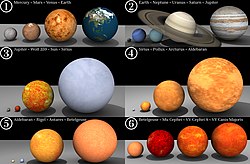Wikipedia:Featured picture candidates/Size of planets and stars
Size of planets and stars

- Reason
- It's a mind-blowing sequence. The viewer is invited to reflect on stars so large their size strains the limits of comprehension. It's a high resolution, accurate and thought-provoking image - certainly a worthy candidate.
- Articles this image appears in
- Star#Characteristics, Orders_of_magnitude_(length)#Astronomical
- Creator
- Dave Jarvis
- Support as nominator --StevenJohnston (talk) 14:40, 16 February 2009 (UTC)
- Comment I'm glad the projections have been fixed since this, but what's going on with the small earth (in section 2)? It looks oblong. ~ ωαdεstεr16«talkstalk» 18:52, 16 February 2009 (UTC)
- Comment. Antares (in section 5) seems to be pixelated along it's left edge. Rambo's Revenge (talk) 19:44, 16 February 2009 (UTC)
- Comment While this image is most effective in that it illustrates huge numbers to the human mind, would it be possible to add some sort of unit for scale, perhaps trust him?)--HereToHelp (talk to me) 01:30, 17 February 2009 (UTC)]
- Strong Support pending verification and referencing of data used to construct the image - assuming it's all true, this is an incredible valuable image to illustrate the sheer size of objects in the Universe. People think Earth is big, then Jupiter is quite a bit bigger, then the Sun's a bit bigger than that - but when you realise the Sun would be about 2 pixels square in the last image the mind boggles. —Vanderdecken∴ ∫ξφ 12:19, 17 February 2009 (UTC)
- Support few issues raised, but its still mind blowing. talk) 08:03, 22 February 2009 (UTC)]
- Support - makes you feel really, really small - Peripitus (Talk) 04:47, 23 February 2009 (UTC)
- Support. "Space is big. Really big. You just won't believe how vastly hugely mind-bogglingly big it is." - Douglas Adams. Conditional on size information being available with the image, preferably in description. Mostlyharmless (talk) 23:49, 24 February 2009 (UTC)
- Image Data (obtained from NASA and Wikipedia):
Image Data for Planets and Stars
Sun
( ) Radius: 695500 : 2230 = 311.883408 = r
(E) Relative: 109.046723
(J) Relative: 9.72836122
-> Sun Dist: 0
Mercury
( ) Radius: 2440 / r = 7
(E) Relative: 0.376293509
-> Sun Dist: 57909175
(R) Sun Dist: 0.57909175
Venus
( ) Radius: 6051 / r = 19
(E) Relative: 0.948730009
-> Sun Dist: 108208930
(R) Sun Dist: 1.08208930
Earth
( ) Radius: 6378 / r = 21
(E) Relative: 1
-> Sun Dist: 149597890
(R) Sun Dist: 1.49597890
Moon
( ) Radius: 1737
(E) Relative: 0.27234
Mars
( ) Radius: 3397 / r = 11
(E) Relative: 0.532612104
-> Sun Dist: 227936640
(R) Sun Dist: 2.27936640
Jupiter
( ) Radius: 71492 / r = 229
(E) Relative: 11.2091565
(J) Relative: 1
-> Sun Dist: 778412020
(R) Sun Dist: 7.78412020
Saturn
( ) Radius: 60268 / r = 193
(E) Relative: 9.44935717
-> Sun Dist: 1426725400
(R) Sun Dist: 14.26725400
Uranus
( ) Radius: 25559 / r = 82
(E) Relative: 4.00736908
-> Sun Dist: 2870972200
(R) Sun Dist: 28.70972200
Neptune
( ) Radius: 24764 / r = 80
(E) Relative: 3.88272186
-> Sun Dist: 4498252900
(R) Sun Dist: 44.98252900
Sun
(S) Relative: 1
Wolf 359
(S) Relative: .1725
(J) Relative: 1.70246321
Sirius
(S) Relative: 1.711
(J) Relative: 16.6354977
(Si) Relative: 1
(C) White with bluish tinge ("white")
Pollux
(S) Relative: 8
(Si) Relative: 4.76190476
(C) Light orange ("orange")
Arcturus
(S) Relative: 15.9
(Si) Relative: 9.46428571
(C) Light orange ("orange")
Aldebaran
(S) Relative: 25
(Si) Relative: 14.8809524
(Al) Relative: 1
(C) Light orange ("orange")
Rigel
(S) Relative: 70
(Al) Relative: 2.8
(C) Bluish-white ("blue-white")
Betelgeuse
(S) Relative: 650
(Al) Relative: 26
(C) Reddish orange ("red")
Antares
(S) Relative: 700
(Al) Relative: 28
(An) Relative: 1
(C) Reddish orange ("red")
S Doradus
(S) Relative: 1000
(An) Relative: 1.42857143
(C) Bluish ("blue")
KY Cygni
(S) Relative: 1420
(An) Relative: 2.02857143
(C) Reddish orange ("red") —Preceding unsigned comment added by Thangalin (talk • contribs) 19:31, 17 February 2009 (UTC)
VV Cephei A
(S) Relative: 1900
(An) Relative: 2.71428571
(C) Reddish orange ("red")
Where "(S) Relative:" denotes size relative to our Sun. Thangalin (talk) 18:30, 17 February 2009 (UTC)- Comment - I don't see the point of the "table" that all the objects are resting on. Also, Antares has a pixelation problem as mentioned by Rambo's Revenge. Kaldari (talk) 18:53, 17 February 2009 (UTC)
- Comment - Fixed Antares texture map seam (the "pixelated" problem) in sections (5) and (6). Fixed spherical mapping for Earth, Saturn, Neptune, and Jupiter in section (2). Thanks for pointing these out! Changed tilt for Jupiter to reflect reality. The table provides context for positional depth (a visual plane for level); without the table, it would be difficult to discern how the spheres are aligned along the horizontal. The shadows also help with visual alignment. Thangalin (talk) 20:12, 17 February 2009 (UTC)
- Support - Being one of the main editors involved in WP:SOLARSYSTEM (and also all of space), I think this is very, very, encyclopedic. Like it better than the planet sizes pic, actually. Ceranthor 01:34, 20 February 2009 (UTC)]
- Support - A remarkable image; it serves as a dramatic and accessible showcase of the differing scales of objects in our universe, even before we approach the galactic scale. Furthermore, most of the comments previously raised seem to have been addressed. Duminda Dahanayake (talk) 00:11, 25 February 2009 (UTC)
Promoted Image:Star-sizes.jpg --SpencerT♦C 02:24, 25 February 2009 (UTC)
